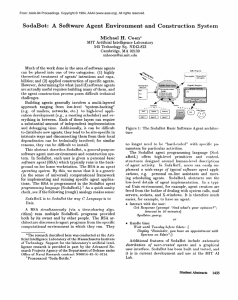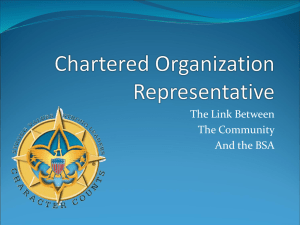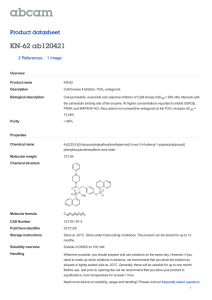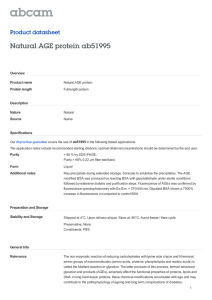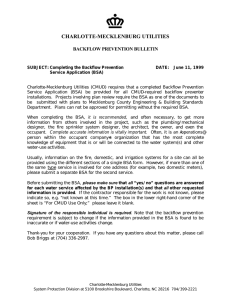Cross-Linked Albumin as Supporting Matrix in Ultrathin Cryo Microtomy
advertisement
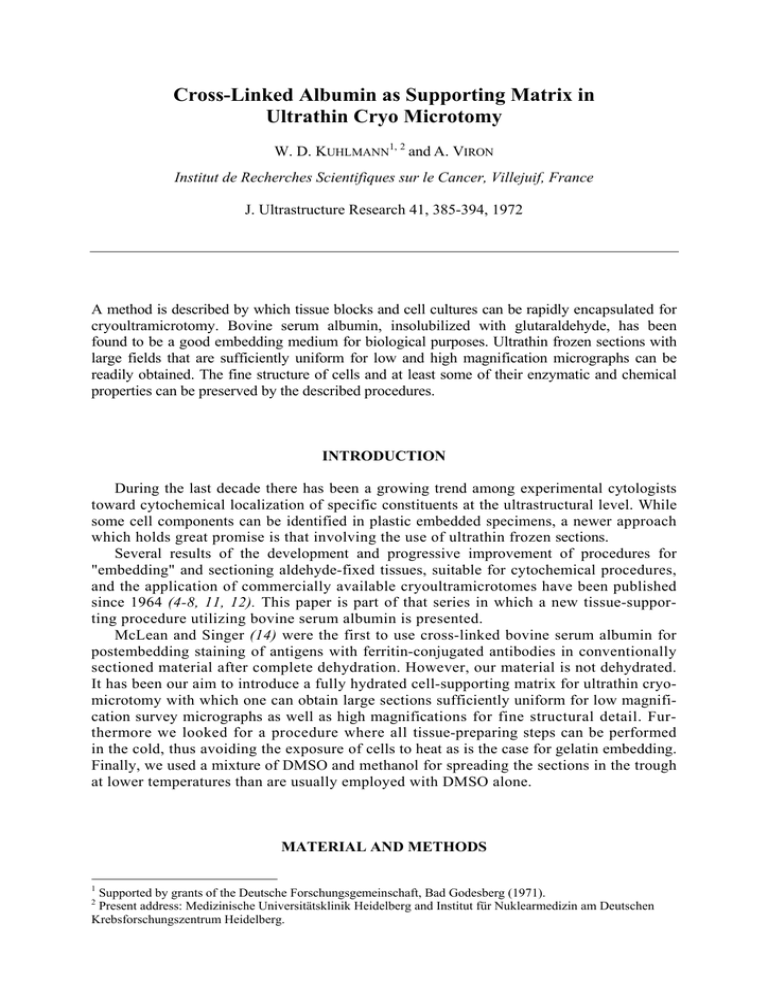
Cross-Linked Albumin as Supporting Matrix in Ultrathin Cryo Microtomy W. D. KUHLMANN1, 2 and A. VIRON Institut de Recherches Scientifiques sur le Cancer, Villejuif, France J. Ultrastructure Research 41, 385-394, 1972 A method is described by which tissue blocks and cell cultures can be rapidly encapsulated for cryoultramicrotomy. Bovine serum albumin, insolubilized with glutaraldehyde, has been found to be a good embedding medium for biological purposes. Ultrathin frozen sections with large fields that are sufficiently uniform for low and high magnification micrographs can be readily obtained. The fine structure of cells and at least some of their enzymatic and chemical properties can be preserved by the described procedures. INTRODUCTION During the last decade there has been a growing trend among experimental cytologists toward cytochemical localization of specific constituents at the ultrastructural level. While some cell components can be identified in plastic embedded specimens, a newer approach which holds great promise is that involving the use of ultrathin frozen sections. Several results of the development and progressive improvement of procedures for "embedding" and sectioning aldehyde-fixed tissues, suitable for cytochemical procedures, and the application of commercially available cryoultramicrotomes have been published since 1964 (4-8, 11, 12). This paper is part of that series in which a new tissue-supporting procedure utilizing bovine serum albumin is presented. McLean and Singer (14) were the first to use cross-linked bovine serum albumin for postembedding staining of antigens with ferritin-conjugated antibodies in conventionally sectioned material after complete dehydration. However, our material is not dehydrated. It has been our aim to introduce a fully hydrated cell-supporting matrix for ultrathin cryomicrotomy with which one can obtain large sections sufficiently uniform for low magnification survey micrographs as well as high magnifications for fine structural detail. Furthermore we looked for a procedure where all tissue-preparing steps can be performed in the cold, thus avoiding the exposure of cells to heat as is the case for gelatin embedding. Finally, we used a mixture of DMSO and methanol for spreading the sections in the trough at lower temperatures than are usually employed with DMSO alone. MATERIAL AND METHODS 1 Supported by grants of the Deutsche Forschungsgemeinschaft, Bad Godesberg (1971). Present address: Medizinische Universitätsklinik Heidelberg and Institut für Nuklearmedizin am Deutschen Krebsforschungszentrum Heidelberg. 2 All steps were carried out in the cold room at 4°C. Tissues. Liver, kidney, stomach, optic nerve, and lymph node were taken from rats (WAG). Cell cultures (CV1) infected with Reovirus III were also used. The organs were dissected out from animals under ether anesthesia and fixed immediately. Cell cultures were fixed in situ after removal of the culture medium. Fixation. Formaldehyde freshly prepared from paraformaldehyde (Merck) and purified and stabilized glutaialdehyde (TAAB) were used at varying concentrations. The tissues were sliced rapidly with a razor blade into cubes of approximately 1 mm3 in a drop of ice cold fixative, and fixed in: (a) 2.5% glutaraldehyde in 0.2 M cacodylate or 0.1 M phosphate buffer at pH 7.2 for 15, 30, and 60 minutes; (b) 1 % formaldehyde plus 1.25% glutaraldehyde in 0.2 M cacodylate or 0.1 M phosphate buffer at pH 7.2 for 30 minutes; (c) 4% formaldehyde in 0.2 M cacodylate or 0.1 M phosphate buffer at pH 7.2 for 60 minutes. After fixation the tissues were either washed overnight by several changes of the corresponding buffer or were immediately transferred into the bovine serum albumin medium for envelopment. Envelopment with bovine serum albumin (BSA). Bovine serum albumin (Povite, Amsterdam) of 10, 15, and 20% was used by appropriate dilution of the 30% stock solution with either 0.2 M cacodylate or 0.1 M phosphate buffer at pH 7.2. The blocks of prefixed tissues were blotted dry and transferred into a wide, flat-bottomed polyethylene vial containing the BSA. After swirling the tissue blocks in the BSA for a few seconds, glutaraldehyde was used as a cross-linking agent (2). Polymerization was obtained either by application of 10 mg of glutaraldehyde per 100 mg proteins in the BSA solution, or enough stock glutaraldehyde (25 %) was added drop-by-drop with continuous agitation of the mixture to obtain a final concentration of 2.5% glutaraldehyde in the BSA-buffer mixture. The BSA polymerized around the blocks in about 30 seconds. Then the walls of the polyethylene tube were cut away with a razor blade and the insolubilized BSA was cut into small cubes slightly larger than the tissue blocks within them. The cell cultures, fixed as described above, were scraped off the culture flask, transferred to centrifuge tubes containing the BSA solutions, and spun down in a refrigerated centrifuge at 800 g during 10 minutes. The supernatant was discarded and the cells were polymerized with the remaining BSA by depositing a drop of 10% buffered glutaraldehyde on the pellet. The insolubilized mixture was detached from the tube with a needle and cut into cubes as described above. After embedding, some blocks were postfixed with 1-2.5% buffered glutaraldehyde during 10-30 minutes, followed by several washings, but other preparations were sectioned immediately. If the blocks should be stocked, all encapsulated tissue preparations were washed during at least 6 hours in several changes of buffer, and finally stored in the cold room in an excess of buffer up to 2-3 months. Ultrathin frozen sections. Prior to freezing and sectioning, the BSA enveloped blocks may be pretreated with 20% dimethyl sulfoxide (DMSO) buffered with cacodylate for 10-20 minutes, but this is not essential. The organ preparations were then frozen on a tissue holder by immersing both into liquid nitrogen-cooled isopentane. Sections were made with either the Sorvall cryokit for the MT2 microtome (Sorvall), the Reichert Om U2 ultramicrotome with the Shandon freezing equipment (Opt. Werke Reichert, Vienna) or with the LKB cryokit (LKB, Stockholm). The sections were spread in the trough either on 50% DMSO as described elsewhere (6) at -50°C or on 50% DMSO plus 10% methanol in distilled water at -70°C and collected with Marinozzi rings. According to the staining procedure desired, the sections were washed at room temperature in buffer or distilled water. Staining procedures and electron microscopy. Positive and negative staining were performed as described by Bernhard and Viron (6). Kidney was used to reveal the sites of alkaline phosphatases by floating the sections on the substrate of Hugon and Borgers (9, 10). Furthermore, we employed the acid PTA technique to demonstrate polysaccharide components as described by Babai and Bernhard (3). The sections were mounted on Formvar and carbon-coated 200-mesh copper grids and examined in a Siemens Elmiskop I operating at 80 kV and with a 50 µ objective aperture. RESULTS The BSA-enveloped tissues and cell preparations examined in this study could be readily cut with the above-mentioned cryomicrotomes. Most experiments have been done with 15% bovine serum albumin as enveloping material, but 10% and 20% BSA could be used with equal ease. The cross-linking of the BSA medium was effective at alkaline pH and occurred in the cold in the presence of 10 mg glutaraldehyde per 100 mg proteins within 4-5 minutes. More rapid polymerization within 30 seconds occurred at a final concentration of 2.5% glutaraldehyde in the tissue blocks containing BSA solution. We observed no differences in ease of sectioning or in structural preservation whether the prefixed tissues were washed or not before envelopment in BSA and, furthermore, the organs could be cut immediately after the cross-linking was finished. In most experiments, however, we washed the preparations and stocked them in buffer in the cold room. Even after 2 months the preparations could be sectioned as described above without visible loss of ultrastructural detail and no dehydration artifacts were observed. Best tissue conservation was found after prefixation of the organs in 2.5 % glutaraldehyde and glutaraldehyde-formaldehyde mixtures. Fixation in formaldehyde alone gave irregular results. We did not try unfixed specimens in our system as the cross-linking of BSA with glutaraldehyde may cause some fixation of the cell preparations and this effect is hard to control. At low magnifications (Figs. 1-3) one observes on a given grid regularly wrinkle-free sections with remarkably few artifacts such as extractions and shrinkages of cellular components even when DMSO treatment prior to freezing has been omitted (Fig. 4). At higher magnification views (Fig. 2 inset) fine structural detail could be well determined. As demonstrated by the alkaline phosphatase reaction (Fig. 5) and the acid PTA staining of polysaccharides (Fig. 6), cytochemical reactions were possible and comparable to those described by other cryoultramicrotomy procedures (3, 5, 11). DISCUSSION The purpose of the present paper was to describe a procedure for cryoultramicrotomy of biological tissues which is easy to handle and gives reproducible results. Three main points arose from our study: (a) by utilizing cross-linked BSA as a tissue support, all cell preparations could be performed at 4°C; (b) BSA enveloped organs showed good spreading qualities on the liquid surface of the trough, even after prolonged storage; (c) cytochemical reactions were possible on the sections. Tissue preparation. Although ultrathin frozen sections of aldehyde-prefixed tissue can be obtained without enveloping the tissue in a supporting matrix (11, 12), Bernhard and Viron (6) have shown that a gelatin support improves the number of the sections which can be utilized for fine structural and cytochemical purpose. FIG. 1-6. All tissues presented have been encapsulated by 15% bovine serum albumin at 4°C. The sections were made with the Sorvall MT 2 (Fig. 1), or with the LKB cryokit (Fig. 2), or with the Reichert cryoultramicrotome (Figs. 3-6). FIG. 1. Rat stomach fixed in 2.5% glutaraldehyde for 30 minutes. Pretreatment with 20% DMSO and sectioned on 50% DMSO in the trough at about -50°C. Negative stain. Note slight retraction artifacts around secretion granules (→). x 5 400 FIG. 2. Optic nerve fixed in 1% formaldehyde plus 1.25% glutaraldehyde for 30 minutes. Pretreatment with 20% DMSO, section floated on 50% DMSO at -50°C. Negative stain. x 16 200. Inset: High power view of the myelin pattern in adjacent nerve fibers. x 81 000. FIG. 3. Liver fixed in 2.5% glutaraldehyde for 60 minutes. Pretreated with 20% DMSO and sectioned on 50% DMSO plus 10% methanol at -70°C. Positive stain. Good preser-vation of nucleus (N) and cytoplasm fine structure; chromatin (chr), mitochondria (m), endoplasmic reticulum (→). x 17 200. FIG. 4. Liver fixed as in Fig. 3. No pretreatment with DMSO, sectioned on 50% DMSO plus 10% methanol at -70°C. Negative stain. Mitochondrial cisternae (→) are readily seen; bile canaliculus (bc). x 19 000. FIG. 5. Kidney fixed in 1% formaldehyde plus 1.25% glutaraldehyde for 30 minutes, pretreated with 20% DMSO and sectioned on 50% DMSO at -50°C. Reaction for alkaline phosphatase, revealing the microvilli (mv) of the brush border of a proximal convoluted cell. x 36 500. FIG. 6. Kidney fixed in 2.5% glutaraldehyde for 60 minutes; pretreatment with 20% DMSO and sectioned on 50% DMSO at -50°C. Acid PTA stain, revealing the microvilli (mv) of the brush border of a proximal convoluted cell with the subjacent invaginations (→) into the apical cytoplasm. x 30 700. However, the proposition of cross-linked bovine serum albumin as supporting medium offers some technical advantages, that is, all tissue-preparing steps may be performed in the cold (13). But the most critical point is that one can avoid exposing tissues to liquefied gelatin at 37°C and thereby reduce the chances of thermal degradation and extraction of substances, especially if the organs have not been extensively prefixed. Furthermore, since the cross-linking of BSA molecules with each other and with the tissue or cells occurs instantly, one can use the tissues within a very short time for ultrathin sectioning. Spreading qualities and storage of BSA enveloped tissues. Tissues that are often difficult to section when treated with gelatin are easier to handle when they are enveloped in a glutaraldehyde cross-linked matrix of BSA. These blocks seem less sticky than gelatin preparations, and they tend to spread more readily on the surface of the DMSO at -50°C in the trough of the knife, so that broader expanses of wrinkle-free sections are available. Better spreading qualities can be obtained by using a mixture of 50 % DMSO plus 10 % methanol, thus allowing to cut the blocks at -70°C in the trough (Figs. 3 and 4). However, we did not control the possibility of extraction artifacts caused by methanol, and thus it may be necessary to restrict this liquid mixture to certain staining reactions. BSA envelopment is extremely useful when prolonged storage of tissue is desired, in that no progressive dehydration of the cells occurs as can be observed in gelatin-treated specimens, even at 3-4°C. Organs stocked in cross-linked BSA at 4°C could be cut up to 2-3 months after their preparation, and the ultrastructure of cells was still well preserved. Cytochemical reactions. The proposition of another tissue-supporting medium for ultrathin cryomicrotomy enlarges the number of choices available to investigations of ultrastructural cytochemistry. Glutaraldehyde, a bipolar molecule which is effective as a cross-linking reagent for proteins, was introduced as a fixative of biological material by Sabatini et al. (15) and has been employed by Avrameas et al. to insolubilize proteins in the preparation of immunoadsorbents (2) or to link different proteins in the preparation of enzyme-labeled antibodies for immunocytochemistry (1). The immunologic and enzymatic properties of the proteins that are so cross-linked are not altered significantly. Then, one can expect that insolubilization of BSA in order to obtain a tissue support for the above described cryoultramicrotomy may give a relatively "inert" cell enveloping matrix. The final concentration of glutaraldehyde employed in the procedure above is that used ordinarily for conservation of cell ultrastructure and insolubilization of enveloping matrix is very rapid. It seems probable that most of the added glutaraldehyde is used for the cross-linking of the BSA matrix. Thus, it is possible that the cross-linking of BSA does not provide further fixation of the tissue, but this has not been ascertained yet. The only cell organelle that might react with the reagent is the cytoplasmic membrane. It is likely that other concentrations of BSA, other proteins or components rich in amino group, and the utilization of more or less cross-linking reagent may serve equally as enveloping matrices, depending on the type of tissue or the cytochemical procedures under investigation. We wish to thank Drs. W. Bernhard and E. H. Leduc for encouragement during this study and Mrs. C. Taligault for preparing the manuscript. REFERENCES 1. 2. 3. 4. 5. 6. 7. 8. 9. 10. 11. 12. 13. 14. 15. AVRAMEAS, S., Immunochemistry 6, 43 (1969). AVRAMEAS, S. and TERNYNCK, T., Immunochemistry 6, 53 (1969). BABAÏ, F. and BERNHARD, W., J. Ultrastruct. Res. 37, 601 (1971). BERNHARD, W. and NANCY, M. T., J. Microsc. (Paris) 3, 579 (1964). BERNHARD, W. and LEDUC, E. H., J. Cell Biol. 34, 757 (1967). BERNHARD, W. and VIRON, A., J. Cell Biol. 49, 731 (1971). DOLLHOPF, F. L. and SITTE, H., Mikroskopie 25, 17 (1969). DOLLHOPF, F. L., WERNER, G. and MORGENSTERN, E., Mikroskopie 25, 33 (1969). HUGON, J. and BORGERS, M., J. Histochem. Cytochem. 14, 429 (1966). HUGON, J. and BORGERS, M., J. Histochem. Cytochem. 14, 629 (1966). IGLESIAS, J. R., BERNIER, R. and SIMARD, R., J. Ultrastruct. Res. 36, 271 (1970). KOLEMAINEN-SEVEUS, L., Proc. 7th Int. Congr. Electron Microsc. 1, 432 (1970). KUHLMANN, W. D. and VIRON, A., J. Microsc. (Paris) 13, 158 (1972). MCLEAN, J. D. and SINGER, S. J., Proc. Nat. Acad. Sci. U.S. 65, 122 (1970). SABATINI, D. D., BENSCH, K. and BARRNETT, R. J., J. Cell. Biol. 17, 19 (1963).
